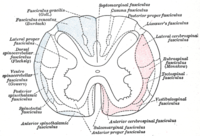
Photo from wikipedia
Because retinitis pigmentosa (RP) has been shown to cause degenerative changes in the entire visual pathway, there is an urgent need to perform longitudinal assessments of RP‐induced degeneration and identify… Click to show full abstract
Because retinitis pigmentosa (RP) has been shown to cause degenerative changes in the entire visual pathway, there is an urgent need to perform longitudinal assessments of RP‐induced degeneration and identify imaging protocols to detect this degeneration as early as possible. In this study, we assessed a transgenic rat model of RP by using complementary noninvasive magnetic resonance imaging techniques, namely, proton magnetic resonance spectroscopy (1H‐MRS), to investigate the metabolic changes in RP. Our study demonstrated decreased concentrations and ratios to creatine (Cr) of N‐acetylaspartate (NAA), glutamate (Glu), γ‐aminobutyric acid (GABA), and taurine (Tau), whereas myo‐inositol (Ins) and choline (Cho) were increased in the visual cortex of Royal College of Surgeons (RCS) rats compared with control rats (p < 0.05). Furthermore, with the progression of RP, the concentrations of NAA, Glu, GABA, and Tau, and the ratios of GABA/Cr and Tau/Cr significantly decreased over time, whereas the concentrations of Ins and Cho and the ratio of Ins/Cr significantly increased over time (p < 0.05). In addition, in RCS rats, NAA/Cr decreased significantly from 3 to 4 months postnatal (p < 0.001), and Cho/Cr increased significantly from 4 to 5 months postnatal (p = 0.005). Meanwhile, the 1H‐MRS indicators in 5‐month postnatal RCS rats could be confirmed by immunohistochemical staining. In conclusion, with the progression of RP, the metabolic alterations in the visual cortex indicated progressive reprogramming with the decrease of neurons and axons, accompanied by the proliferation of gliocytes.
Journal Title: NMR in Biomedicine
Year Published: 2022
Link to full text (if available)
Share on Social Media: Sign Up to like & get
recommendations!